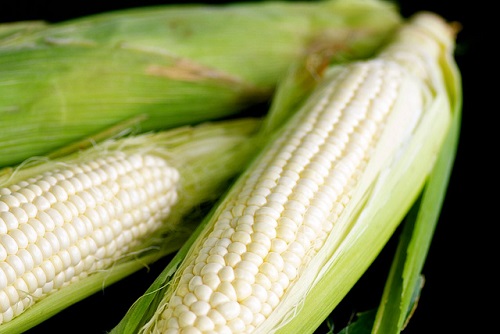Difference Between White and Yellow Corn

White vs. Yellow Corn
Corn, or more properly, maize, is a grain crop that has been a staple food in many parts of the world. Its origins as an agricultural produce can be traced back to the Aztecs and Mayans, and it was then spread through the various expeditions during the Age of Discovery. It became very popular due to its versatility as a crop, growing in a wide variety of climate conditions. Through the years, and thanks to advancements in science, corn has steadily improved in both productivity and nutritional value. One thing that most are unaware of is that there is a wide selection of subspecies of corn. Of the varieties of corn, the two most prevalent are white and yellow corn. The two resemble one another physically, but there are some slight differences.
The word ‘corn’ is actually a misnomer. Originally, it was a term used by the English in reference to any cereal crop. ‘Maize’ is the actual proper name used outside of the Americas and in scientific terminology. The scientific name for corn is zea mays; its subspecies are then referred to as ‘varieties.’ For example, popcorn is zea mays everta. White is the most common coloration of corn, followed closely by yellow corn, while the remaining are referred to as bi-colored (which can range from red to orange-hued varieties.) ‘Corn’ is the term often used in reference to this crop in English speaking countries and almost exclusively for products with heavy concentrations of it (such as corn flakes and corn cereals), regardless of whether it falls under the white or yellow corn variety.
Most white corn is generally categorized as a variety of sweet corn. While most corn is of the field corn variety (i.e. treated as a grain), sweet corn is harvested during the immature stage and treated as a vegetable. White sweet corn is actually a mutation of the regular field corn with a higher sugar than starch ratio of content. Unlike field corn, which is commonly used as a grain product for such things as livestock fodder and other processed food like cereals, oil, starch, etc., sweet corn is consumed as a vegetable and typically eaten on the cob after boiling or roasting. As it grows on the stalk, white corn becomes wrapped in layers from green husks to white husks. It also has a high water content compared to field corn. The kernels and the ‘milk’ that comprise it are colored white. However, just as regular corn, white corn kernels become hardy and tough as the water content decreases as a result of its maturation. White corn is the more common variety and is, technically, the original, as other-colored corn varieties are mutations of the white ‘parent.’

Yellow corn is very similar to white corn; it is actually an evolutionary offshoot of white corn. As corn was further cultivated, research and scientific development produced different varieties from the original species. One of the mutations from the inherent recessive gene of corn is the inclusion of carotenoids within the corn’s composition. These carotenoids include beta-carotene. Because of this, yellow corn can be considered as having more nutritional value than its white counterpart. According to experts, some varieties of yellow corn have more lutein and contain Vitamin A, while white corn does not. Yellow corn is also not particularly popular in certain areas of the world, such as parts of Latin America and the continent of Africa.
- Differences Between Fraternity And Sorority - January 8, 2014
- Differences Between Lucite and Plastic - January 7, 2014
- Differences Between Oil and Butter - January 6, 2014
Search DifferenceBetween.net :
6 Comments
Leave a Response
References :
[0]http://foodblogga.blogspot.in/2011/05/sweet-corn-season-has-begun-in-san.html
[1]https://pixnio.com/flora-plants/crops/yellow-corn-plant-harvest

It’s pretty sad when you research things on the internet and find so many conflicting information. Even your article here contradicts itself. You said in the article that “White sweet corn is actually a mutation of the regular field corn with a higher sugar than starch ratio of content.” Then in your summary you say “Yellow corn is a genetic mutation of white corn.” Try to tell people one thing and make it accurate.
OMG, Nancy! I read this article and thought the same thing. I wanted those 3 minutes of my life back. What a waste. How can anyone consider anything in this article accurate after that contradiction. I am washing it all from my brain and looking for a more credible source.
Thought the same thing, the contradiction makes the article worthless.
Field corn is not the same as yellow corn. Field corn refers to the smaller sized crop similar to wheat- the kernels where many times smaller than they are now a few thousand years ago. So the lineage goes like this: field maize, white maize, yellow maize. It’s really not that hard to understand.
Which one is hybrid?
Yellow maize is the hybrid.